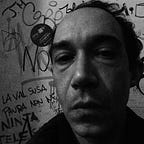Drawing the concentration camp
Notes on a graphic novel about Primo Levi
Read the first part of this story: Rediscovering Primo Levi
When I first started working on a graphic novel about Primo Levi, I was only sure about one thing: I didn’t want to draw the concentration camp. Levi had already told about it, and it was impossible for me even to imagine the camp, let alone draw it. This is one of the reasons why A Tranquil Star (the title of my graphic novel about Levi) starts in 1945, October the 19th, the day of Levi’s homecoming in Turin. In other words, I started where The Truce ends.
But of course the lager is everywhere in Levi’s work, and in some way I had to picture it. Of course I had Maus as an huge precedent, in which Art Spiegelman had been very careful: using the metaphor of the mouses (as the Jews) and the cats (as the Nazis) he avoided drawing human beings, their bodies and their faces. So I thought: I don’t need to draw the camp, I just have to recall it. With this thought in mind, in some points of the book I used a photography that was actually in Levi’s home: the photo of a barbed wire fence coming from I don’t know which concentration camp.
Only once I drew Monowitz’s shacks (the camp where Levi was), but for a sequence where I was actually representing a dream. Anyway I used real photos and I didn’t draw any human being.
In other occasions, Levi’s words would suggest to me what to draw. For example: in the middle of If This Is A Man, in the book’s most important chapter, where Levi talks about the drowned, the huge mass of prisoners who have not survived, there is an image:
“They crowd my memory with their faceless presences, and if I could enclose all the evil of our time in one image, I would choose this image which is familiar to me: an emaciated man, with head dropped and shoulders curved, on whose face and in whose eyes not a trace of a thought is to be seen”.
So it was easy for me drawing faceless prisoners.
But those words — “they crowd my memory” — kept struck inside me. How it was like to bring inside for all your life that image, that wound? What images were inside Levi’s memory? There is a thing Levi often repeated, in different interviews, a thing a friend of him once told him: “You lived that period in technicolor, while the rest of your life is in black and white”. I didn’t have the slightest idea about how to render this until someone showed me the works of Zoran Music, a Slovenian painter detained in Dachau as a politic prisoner.
Music followed Levi’s same path, but he used drawings instead of words. When he was in Dachau and immediately after it he drew obsessed by what he was seeing (he drew almost only dead bodies). In the same way, Levi had already began to write If This Is A Man when he was still detained in Monowitz, risking his life in doing this (writing was prohibited). Several years after, Music came back to draw those bodies, in a series of paintings called We Are Not The Last. Similarly Levi came back to write about the lager with the essay The Drowned And The Saved. I thought Music’s drawings were as close as possible to the images that Levi had to carry in his mind, and I didn’t have any hesitations in copying them (even if I used oil pastels and a black pencil) and in using them in oder to illustrate Levi’s quotes from If This Is A Man and The Drowned And The Saved.
So I did the opposite operation in respect to Levi’s words: the lager in black and white, all the rest in color. As someone said in a Wim Wenders movie: “Life is in color, but black and white is more realistic”.
Follow Expost Magazine on Twitter | Facebook | Medium
Sign-up to the newsletter: po.st/Weekly
If you enjoyed reading this, please click “Recommend” below.
This will help to share the story with others.
